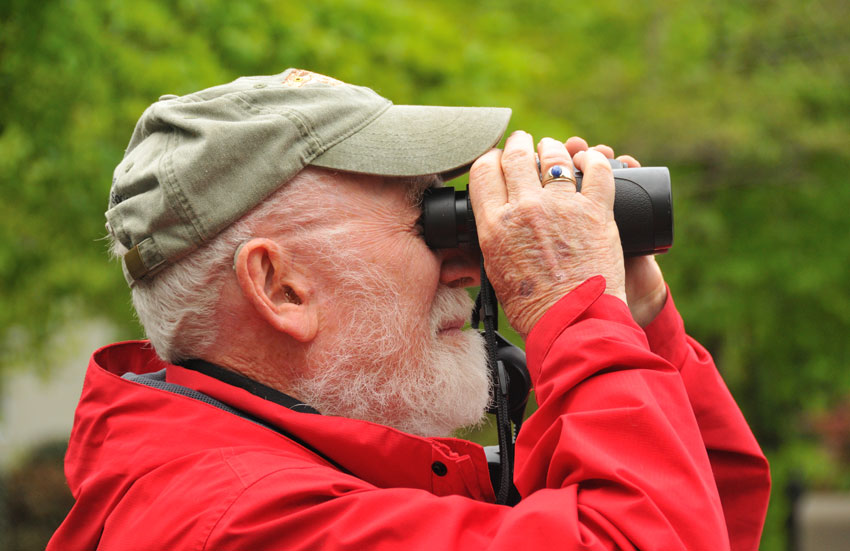By David Brill
Each spring, for more than 60 years, Ed Clebsch, retired UT Knoxville professor of botany and ecology who also is an alumnus, has trod the pilgrim’s path, guiding amateur naturalists toward greater awareness of the flowering plants of the Great Smoky Mountains. Writer David Brill joined Clebsch for a hike during the 2012Wildflower Pilgrimage.
– – –
Ed Clebsch isn’t the least bit daunted by a frank discussion of sexual reproduction, and neither are the dozen men and women who cluster around him, straining to get a closer look at the visual aid Clebsch holds in his hands: in this case, the blossom of Calycanthus floridus, better known among nonbotanists by its common name, sweetshrub.
Clebsch, UT Knoxville emeritus professor of botany and ecology, and his colleagues, Fred Holtzclaw, a science teacher at Webb School in Knoxville, and Roger Hedge, an ecologist with the Indiana Department of Natural Resources, are the featured instructors for this “Birding and Wildflower Motorcade,” which began earlier this morning at Mynatt Park on the outskirts of Gatlinburg and will end, after numerous stops, late this afternoon at Newfound Gap in Great Smoky Mountains National Park.
The motorcade is one of more than 100 expert-guided outdoor programs that are part of the park’s Annual Spring Wildflower Pilgrimage, a collaboration among the national park, the UT Knoxville Department of Ecology and Evolutionary Biology, the Southern Appalachian Botanical Society, the city of Gatlinburg Department of Tourism, the Friends of Great Smoky Mountains National Park, the Gatlinburg Garden Club, the Great Smoky Mountains Association, the Tennessee Valley Authority and the Arrowmont School of Arts and Crafts.
Each year, the pilgrimage attracts hundreds of budding amateur botanists from most of the 50 states and numerous foreign countries to the park for the five-day event.UT botanists helped organize the first pilgrimage in 1950 and continue to play a role in selecting and providing trip leaders. Clebsch (Knoxville ’55, ’57) missed the first event (he was in the U.S. Army at the time) but has served as an instructor for all but five pilgrimages since. He’s quick to acknowledge the valuable publicity the annual event—which he terms “the botany department’s extension service”—provides for UT’s professors and scientific programs.
Ken McFarland, chair of the pilgrimage organizing committee and lecturer in UT Knoxville’s biology department, agrees. “As a land-grant university, UT extends its expertise beyond the campus to serve the citizens of the state and nation,” says McFarland. “For the past 63 years, the annual pilgrimage has been a mainstay of UT’s educational outreach.”
Each year, the pilgrimage attracts hundreds of budding amateur botanists from most of the 50 states and numerous foreign countries to the park for the five-day event.
Among them this year are the 12 eager participants, gathered near the park’s Twin Creeks Science and Education Center, who take turns peering through a hand lens at sweetshrub’s exposed sex parts, as Clebsch and Holtzclaw elaborate on “the birds and the bees” or, in this case, the beetles, as they apply to the plant.
One of the oldest flowering plants in the park, sweetshrub lures its pollinators, small beetles, by exuding a sweet perfume. (Clebsch explains that Appalachian women often placed the fragrant blossoms in their bodices, which earned the plant the nickname “bubby bush.”) The petals of the plant’s maroon flower further entice its pollinators by sharing their color with that of rotting fruit or meat.
As Clebsch and Holtzclaw explain, the blossom’s tight cluster of petals provides the beetle access but blocks its exit, allowing the beetle to escape only after the plant has released its pollen. The beetle then becomes an unwitting participant in the shrub’s lifecycle, carrying the pollen into other sweetshrub blossoms and resulting in cross fertilization.
If the story of sweetshrub’s procreation fails to arouse the pilgrims, there are myriad other botanical specimens sprouting through the leaf litter in the park to capture their attention. Indeed, the park’s rich botanical and biological reserves—including 1,600 species of flowering plants, the most of any national park—led to its designation as an International Biosphere Reserve in 1976 and a World Heritage Site in 1983. But the blossoms of the real show-stoppers—violets, fire pink, spring beauty, trillium, bloodroot, trout lilies, dwarf crested iris—are conspicuously absent.
Over the course of an hour, the trip leaders decode the aural signals emanating from the branches and identify grosbeaks, juncos, ovenbirds, eastern phoebes, brown thrashers and eastern towhees.Though the park is renowned for its botanical diversity, this year, it’s not particularly noted for its timing. An early and unusually warm spring prompted the aptly named ephemeral flowering plants to begin and end their showy display in March, a month in advance of the pilgrimage.
Though the first successional wave of flowering plants may have crested, Clebsch, Holtzclaw and Hedge find plenty to study and share with their group. Old man’s beard (Chionanthus virginicus), fringed phacelia (Phacelia fimbriata), blue cohosh (Caulophyllum thalictroides), flame azalea (Rhododendron calendulaceum), cinnamon fern (Osmundastrum cinnamomeum), false Solomon’s seal (Maianthemum racemosum) and showy orchis (Galearis spectabilis) offer themselves up for inspection.
The on-the-ground display is only half of the program which, as advertised, also involves study of the birds flitting among the trees above. Midafternoon, at the pilgrimage’s last stop, the group departs the parking lot at Newfound Gap, at 5,050 feet above sea level, and enters a mist-shrouded forest teeming with avian life. The pilgrims and their instructors, binoculars pressed tight against eye sockets, peer upward, but the dense, swirling mist deprives them of a clear view of many of their subjects.
The chirps and tweets issuing from the canopy sound distinct but not necessarily distinguishable to the pilgrims’ untrained ears. Not so to those of the pilgrimage leaders. All three are polyglots well versed in the language of birds and capable even of differentiating among similar species within the same genus, based on sound alone.
At one point, Hedge pauses, his ear cocked.
“Did you hear that?” he asks Clebsch. “A red-eyed vireo?”
“Doubtful,” Clebsch responds. “The call is too slow. Probably a blue-headed vireo.”
Over the course of an hour, the trip leaders decode the aural signals emanating from the branches and identify grosbeaks, juncos, ovenbirds, eastern phoebes, brown thrashers and eastern towhees.
Then there are the warblers, the small (some barely larger than a man’s thumb), vocal and often colorful birds that winter in Mexico and parts south and grace East Tennessee with their presence each spring on their way north as far as Canada.
The timing may have been off for viewing the ephemeral wildflowers, but it’s perfect for hearing—if not seeing—these neotropical migrants, prized among birding enthusiasts for the beauty of their coloring and the richness of their calls.
While the pilgrims catch occasional flashes of plumage as the birds flit from branch to branch, the three instructors, with hands cupped behind ears, call out their discoveries: “Black-and-white warbler!” “Chestnut-sided warbler!” “Black-throated blue warbler!” “Yellow-throated warbler!”
At 4:30 p.m., the pilgrimage’s appointed end time, Holtzclaw cranes to listen, pauses and then announces to the group that he’s detected an entirely new call: “Hear that?” he asks. “That means it’s beer time.” And with that, the instructors usher the pilgrims through the mist and back to their cars for the trip down the mountain. Over the course of nearly eight hours, they’ve endured rain, hail and a wafting mist, all while gaining new knowledge of the birds and plants of the park.
But Clebsch is convinced they’ve gained something more. He should know; he’s been shepherding pilgrims along the trails of the Smokies for more than half his life.
“Over the years, some people have taken issue with the use of the term ‘pilgrimage’ to describe this program,” says Clebsch. “But I’m glad they’ve stuck with it because it gets at the heart of the awakening that happens out here. The interactions among people interacting with the natural world always engender an awareness, an acuity of surroundings.”
Not a bad reward for a walk in the park.
The 2013 Spring Wildflower Pilgrimage was held April 23-27. For more information, visit www.springwildflowerpilgrimage.org/.



